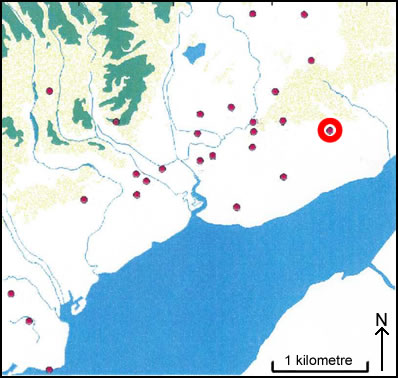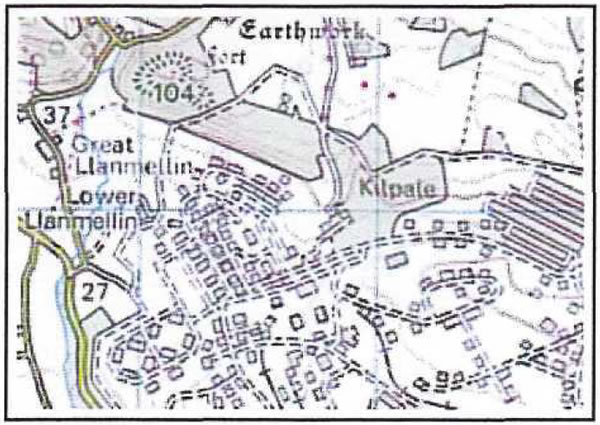Hillforts of Gwent - In Search of the Iron Age
From a 2001 dissertation by Caroline Martin
Llanmellin Wood Camps – Caerwent
By Caroline Martin
First published 2001

Location of Llanmellin Wood Camps

Llanmellin Wood Camp as seen on OS 1902 map
Image reproduced with kind permission of Ordnance Survey and Ordnance Survey of Northern Ireland
At Llanmellin, there is evidence of two hillforts (ST 461 925/ST 463 928) (Figure 7). The site is a small multi-ramparted hillfort and was excavated in the 1930s by V.E. Nash Williams. The site is made up of two features: The main elliptical enclosure that follows a 100 meter contour and covers 2.2 hectares and the second feature, which is a narrow rectangular annex butting onto the camp and measures approximately 121.3 m by 69.8 m.
Camp A - Elliptical Enclosure and Annex
This site can be approached from the north by way of a track through the woodland opposite the entrance to Coombe Farm. The camp is comprised of two sections. Camp A is a large, open area surrounded by two sets of banks and ditches that appear to follow the shape of the hilltop. The ground slopes away steeply to the south, west and north west. The entrance appears to be on the south east side. The earthworks are more complex on the north eastern side where there are three sets of banks and ditches. Roughly rectangular in shape the annex projects out towards the south east. It consists of outer banks and ditches that surround an area that is divided into three distinctive sections with each section being separated by a ditch. Finds excavated from this site have been dated to circa 200 BC - AD 75 (Shackleton Hill 1988,1).
Camp B - C shaped enclosure
In the woodland to the east of the track, opposite the entranceway into Coombes Farm there is a 'C' shaped enclosure. The south eastern section is no longer present, this is either due to it never being completed or destroyed by farming activity. From aerial photographs taken in 1994, it would appear that the later is the case (Taylor 1990, 2). The 'C' shaped enclosure is 24 comprised of a single ditch and double embankment. Extensive excavation carried out here in 1930-2 showed that the fort originated in the 3rd century BC. Then around 150 BC the main multivallate enclosure was constructed. Evidence for settlement during this period is sparse in the excavated area but the remains of domestic animals and red deer make it likely that settlement did occur here. The third and final stage at Llanmellin began around 50 BC and involved remodelling and strengthening the entrance. The north eastern sides were cut back and refaced and both sides were given flanking timber platforms and palisades on top of the banks. The annexes were added at this time, possibly for the coralling of animals as there is no sign of human occupation. The whole fort seems to have been abandoned in AD 75.